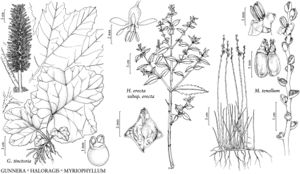Stems to 1 m, scabrous and tuberculate, with red glands and multiseriate hairs. Leaves: petiole (0.5–)0.8–1.7(–3) mm; blade [1.5–]1.8–5[–9] × (0.5–)1–1.7[–3.5] cm, thin [cartilaginous], base attenuate, margins serrate, teeth 18–40, to 2 mm. Inflorescences: bracts petiolate, leaflike, lanceolate to elliptic, 0.5–2[–2.5] × 0.2–1.2 cm, margins serrate, teeth 22; primary bracteoles 0.3–1.3 × 0.1–0.3 mm; secondary bracteoles [0.3–]0.5–0.9 × 0.1–0.2 mm. Pedicels 0.5–1.8 mm. Flowers: sepals red or green, deltate, 0.7–1.2 × 0.4–1 mm, glandular; petals cream or red, 1.5–1.8[–2.2] × 1.2–1.4 mm; keel with red tuberculate glands and multiseriate hairs; filaments to 0.4 mm; anthers yellow or red, linear-oblong, (1.2–)1.4–1.7 × 0.3–0.5 mm; ovary ovate, 0.9–1 × 0.7–1.2 mm, with 4 prominent, antisepalous ridges, locules each with 1 pendulous ovule; stigmas red, capitate, to 0.1 mm. Fruits obturbinate or pyriform to ovoid, 1.8–3 × 1.5–2.5(–4) mm, with 4 antisepalous, longitudinal ridges, ridges often with membranous, deltoid wings to 0.8 mm wide, surfaces smooth to rugose; stipes 0.8–1.3 mm; sepals erect, broadly deltoid. 2n = 14.
Phenology: Flowering and fruiting Jun–Sep.
Habitat: Open, disturbed areas.
Elevation: 0–100[–1000] m.
Distribution
Introduced; Calif., Pacific Islands (New Zealand).
Discussion
Subspecies erecta is known from the San Francisco Bay area from Golden Gate Park and the San Francisco Botanical Garden, where it was intentionally planted. It is sold as the cultivar ‘Wellington Bronze’ or ‘Toatoa.’ The attractiveness and availability of this shrub are likely to contribute to its future spread within milder regions of the United States.
Selected References
None.
